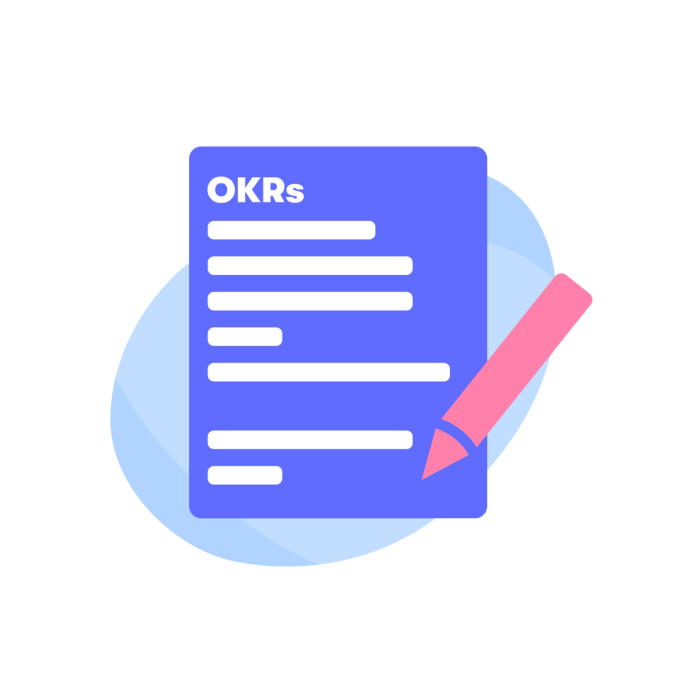How to write OKRs: The basics
OKR is a framework for navigating in uncertainty, giving you the tools to make decisions in complex environments. Objectives and key results help your company bring its vision, strategies, and business goals into clear alignment. It provides a structured process for making decisions and puts the focus on outcomes rather than output.
Before we begin, let’s first go over the main components of OKR:

OKR - Stands for objectives and key results. It’s the short-term plan that works towards the overarching vision and strategy. OKRs are generally implemented on a quarterly basis.
Objectives - Defined as a desired and completed future state. An objective describes “what” you intend to achieve within the quarter. It’s the business outcome or abstract goal of the cycle.
Key Results - Key results communicate “how” you intend to meet your objectives. As the success drivers of the objective, key results describe a measurable outcome that is considered achieved at 70% or greater.
Initiatives - While not technically a part of OKRs, initiatives are actionable tasks needed to fulfill the key results. Managers and employees decide precisely what needs to be done and by when.
Put together, these components are referred to as “OKR sets.” Each OKR set should consist of a maximum of five objectives and up to four key results per objective. Companies using OKR often use OKR sets at each level, with each set having an individual owner. Here’s how that might look:
- Company OKR Set ➔ CEO
- Department/team OKR sets ➔ Department head or team leads
- Personal OKR Sets ➔ Employees
While these individuals may “own” each OKR set, that doesn’t mean they’re the only ones responsible for their achievement. However, it does mean that they are the ones responsible for saying “no” to activities that are not included in the OKR sets.
All OKR sets, including results and goals, should be transparent to everyone (best achieved by using OKR software). The OKR sets are linked to each other, meaning the company objectives and key results will have no initiatives, but the department/team OKR sets will link to the company key results and pay into the company objectives.
How to write an OKR set
OKR is often described as “the art of saying no;” otherwise, knowing which ideas not to pursue (this time–maybe next quarter!). It’s all about saying “no” to opportunities that will distract from the essential focuses which first need to be achieved. The company OKR set should contain all of the objectives that will be pursued in the quarter. Everything that is not in the OKRs, is not a priority for this cycle. Only when OKRs are consistently applied according to this principle, is it possible that important trade-offs and resource conflicts become visible. This is why it’s important to include all relevant topics when writing OKRs, including daily business. This results in resources being invested wisely, allowing you to make informed decisions on what to put into the next cycle, and what not. There will always be more goals than resources, meaning prioritization at the start of the quarter is key.
Having clear priorities will allow you to determine what proportion of resources to allocate towards operational topics, versus how much to invest in the future. This ratio will change depending on the state of the company, but usually, there is a ratio of 60/40, with 60% of the resources for operational needs, and 40% for strategic opportunities. For startup companies, this ratio might look different, with more resources dedicated to explorative options since there is not a lot of established daily business yet.
Example of how to write an OKR set
Objectives for a company-level OKR set should take a holistic approach and involve department/ team overarching goals (set with a bottom-up approach).
Example of a company OKR set:
Objective: Our customers are excited about a new feature.
Key result: Net promotor score (NPS) of 40 or higher
Key result: Product rating of at least 4.5
Key result: Improve weekly sign-ups by 15%
Objective: We create a place to work where people feel inspired.
Key result: Achieve a eNPS of at least 80%
Key Result: Reduce turnover by 90%
Key Result: At least 70% of employees participate in professional development opportunities
Once the company OKRs have been written, objectives for the individual and team sets can be determined based on the company’s key results.
How to write objectives
If you’re new to OKRs, writing objectives for the first (or second, fifth, or tenth time) can be challenging. That’s okay–it’s not supposed to be easy! Here are some tips for writing objectives:
An objective describes a state we want to have by the end of the OKR cycle. At the end of the quarter, you should be able to evaluate the objective with either a “yes” or a “no.” Also, you cannot have more than five objectives per set. Your objectives should be written in a way that is easy to remember and inspiring–a wordy, complicated objective won’t be nearly as motivating. The objective should be something that can be directly achieved with your team–not something that you don’t have control over. If you have long-term projects over different cycles, try to break them down into quarterly, achievable goals.
Some great content for objectives could include operational challenges you want to tackle or blockers that regularly occur that you want to overcome. Other objectives could focus on strategic topics or ideas to advance your vision–but make sure that these objectives aren’t evergreen goals. Evergreen goals are goals that you can repeat year after year, but they aren’t objectives in that they can’t be achieved in a 3-month cycle.
- Operational challenges, problems, blockers
- Topics from the vision & strategy
- Evergreens or phrases like increase, improve, reduce, etc
- Reference to business plans, roadmaps, etc.
When writing your objectives, make sure you don’t include words like “increase” or “decrease,” “improve” or “reduce”--these quantifiable terms are better suited to key results. Objectives should be ambitious and unambiguous. Objectives should precisely indicate exactly what you want to achieve–they aren’t open to interpretation. So instead of saying your objective is, “I want to lose weight,” which could be anything from 1lb to 100lbs, a better objective would be “I want to fit into my old jeans by the end of the quarter.”
Objectives should not reference any business plans or roadmaps: These are dependencies that not everyone may understand or be familiar with. Objectives need to be transparent and understandable on every level.

How to write key results
Key results are the levers, or the drivers, of success. They are what will help us to achieve our objective. Each key result should describe a measurable outcome that individually generates an achievement. Going back to the “I want to fit into my old jeans” objective, a great key result would be to increase your caloric burn rate by X amount or to decrease your caloric intake by X amount. Something like “eating healthier” would not be a good key result–it would be an initiative.
Key results can usually be objectively measured on a scale from 1 to 100% (with 70% achievement considered a success). The key results of an objective should be independent of each other. For example, “decreasing caloric intake” and “increasing caloric burn rate” are separate from each other and can be measured independently. If key results are dependent on each other, then the failure of one could cause a blocker for another. In the end, you want to have four separate levers to help you achieve your objective.
Stretch goals, moonshots, and the 10x approach
Stretch goals, moonshots, and the 10x approach are the concepts which made OKR so famous, especially within Google. Stretch goals promise to deliver great results and to help you outperform any competitor. While they do force you to think innovatively and with more agility, they also require enough resources to do so. Therefore, it’s wise to first understand the purpose behind these goals, and then to use them very carefully and with intention.
So why write moonshots into your OKRs? These types of goals are supposed to help you move outside of existing patterns. If Henry Ford had only looked for ways to improve the carriage, he would have never invented the automobile.
These goals should help you think outside the box, think bigger, and leave behind your familiar paths. If you set a goal, “Increase X by 10%,” you can usually achieve this simply by putting in more work and more resources. But if you challenge yourself to do something 10 times better, chances are slim that you can do this with the methods that you’re currently using. This forces you to think about what you can do differently and look for new methods you haven’t seen before.
So it makes sense to have these kinds of goals, but only for the right reasons. That means that you likely won’t have a moonshot goal in every OKR set, or even in every quarter. It depends on what stage your company is currently in.
If it’s important to get your daily business running more efficiently and sustainably, then you might have fewer stretch goals. But if you’re in the exploration phase and you really want to do something new, then such stretch goals are helpful in pushing you to innovation. It’s important to consider if you’re in the right phase or for which reasons you may want to apply these kinds of goals. Check in with your team about their availability and resources to see if they have the capability to work on stretch goals.
Collato's top OKR features
Collato's top OKR features

Unlimited hierarchy levels

Real-time progress tracker



